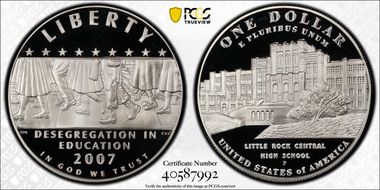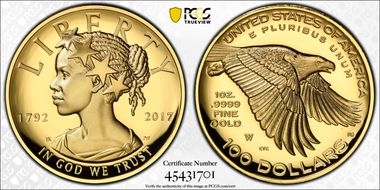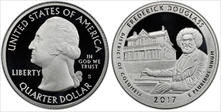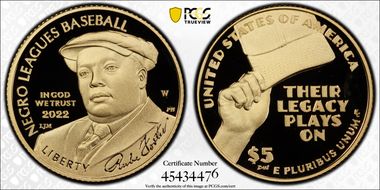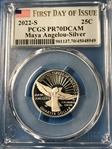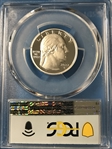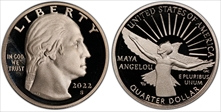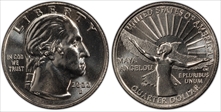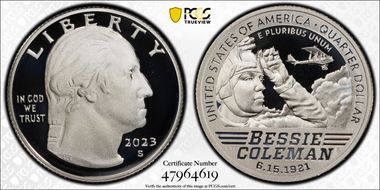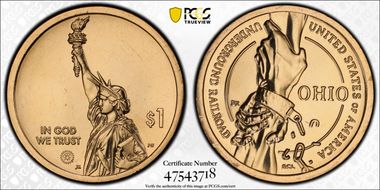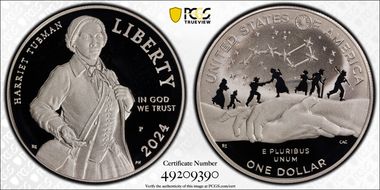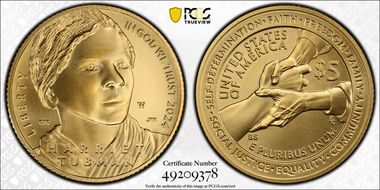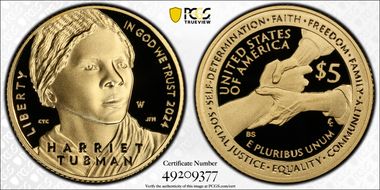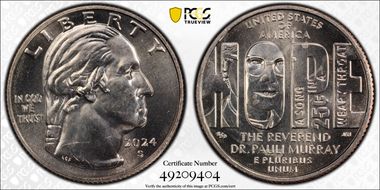AFRICAN-AMERICAN IMAGES ON U.S. COINS, WITH NARRATIVES 的展示图片库
Unknown to most for many years, the famous female figure depicted as Liberty on Saint-Gaudens double eagle (1907-1932) was African-American model Harriette Eugenia “Hettie” Anderson. , She was an African-American model who Saint-Gaudens referred to as a woman with the figure of a goddess. Based on research that surfaced in 1991 and published that year in Numismatic News and subsequent works that also confirms this information, it now appears very likely, if not certain, that the woman who served as the model for Liberty on the obverse of Augustus Saint-Gaudens legendary $20 double eagle gold coin was Hettie E. Anderson, a black American woman with fair complexion. Charles Morgan and Hubert Walker, "African-Americans on US Coins: Circulating Coins (Part 3)',Coin Week, Jan. 22, 2016, https://coinweek.com/coins/commemoratives/african-americans-on-us-coins-circulating-coins-part-3/
Unknown to most for many years, the famous female figure depicted as Liberty on Saint-Gaudens double eagle (1907-1932) was African-American model Harriette Eugenia “Hettie” Anderson. , She was an African-American model who Saint-Gaudens referred to as a woman with the figure of a goddess. Based on research that surfaced in 1991 and published that year in Numismatic News and subsequent works that also confirms this information, it now appears very likely, if not certain, that the woman who served as the model for Liberty on the obverse of Augustus Saint-Gaudens legendary $20 double eagle gold coin was Hettie E. Anderson, a black American woman with fair complexion. Charles Morgan and Hubert Walker, "African-Americans on US Coins: Circulating Coins (Part 3)',Coin Week, Jan. 22, 2016, https://coinweek.com/coins/commemoratives/african-americans-on-us-coins-circulating-coins-part-3/
The Booker T Washington commemorative half dollars were issues for six years, 1946 to 1951. .-African American artist Isaac Scott Hathaway designed 50-cent commemorative coins with the faces of Booker T. Washington in the 1940s and the combined faces of Washington and George Washington Carver in the 1950s. Washington was the first African American to have his face on a commemorative coin, and Hathaway was the first African American to design a U.S. coin.
From 1951 to 1954, the U.S. Mint produced the George Washington Carver-Booker T. Washington Half Dollar. It commemorated the lives of George Washington Carver (1864-1943), an agricultural scientist and educator, and Booker T. Washington (1856-1915), founder of the Tuskegee Institute. The coin was the last commemorative coin made by the Mint until the modern Commemorative Coin Program began in 1982.
Jack Roosevelt Robinson (January 31, 1919 – October 24, 1972) was an American professional baseball player who became the first African American to play in Major League Baseball (MLB) in the modern era. Robinson broke the baseball color line when he started at first base for the Brooklyn Dodgers on April 15, 1947. The Dodgers signing Robinson heralded the end of racial segregation in professional baseball that had relegated black players to the Negro leagues since the 1880s. Robinson was inducted into the Baseball Hall of Fame in 1962.
A stunning tribute to a legendary figure in American sports history. The front side of the coin, designed by Al Maletsky, beautifully depicts Jackie Robinson stealing home plate, a thrilling moment captured during the 1955 World Series between the New York Yankees and the Brooklyn Dodgers. Robinson's dynamic pose is a lasting symbol of his skill, determination, and groundbreaking role in baseball.
During his 10-year MLB career, Robinson won the inaugural Rookie of the Year Award in 1947, was an All-Star for six consecutive seasons from 1949 through 1954, and won the National League (NL) Most Valuable Player Award in 1949—the first black player so honored. Robinson played in six World Series and contributed to the Dodgers' 1955 World Series championship.
In 1997, MLB retired his uniform No. 42 across all major league teams; he was the first professional athlete in any sport to be so honored. MLB also adopted a new annual tradition, "Jackie Robinson Day", for the first time on April 15, 2004, on which every player on every team wears No. 42. Robinson's character, his use of nonviolence, and his talent challenged the traditional basis of segregation that had then marked many other aspects of American life. He influenced the culture of and contributed significantly to the civil rights movement. Robinson also was the first black television analyst in MLB and the first black vice president of a major American corporation, Chock full o'Nuts. In the 1960s, he helped establish the Freedom National Bank, an African-American-owned financial institution based in Harlem, New York. After his death in 1972, Robinson was posthumously awarded the Congressional Gold Medal and Presidential Medal of Freedom in recognition of his achievements on and off the field.
Crispus Attucks (c.1723 – March 5, 1770) was an American whaler, sailor, and stevedore of African and Native American descent, commonly regarded as the first person killed in the Boston Massacre and thus the first American killed in the American Revolution. Historians disagree on whether Attucks was a free man or an escaped slave, but most agree that he was of Native American (specifically Wampanoag) and African descent. Two major sources of eyewitness testimony about the Boston Massacre published in 1770 did not refer to him as "black" nor as a "Negro"; it appears that Bostonians viewed him as being of mixed ethnicity. According to a contemporaneous account in the Pennsylvania Gazette, he was a "Mulattoe man, named Crispus Attucks, who was born in Framingham
Crispus Attucks (c.1723 – March 5, 1770) was an American whaler, sailor, and stevedore of African and Native American descent, commonly regarded as the first person killed in the Boston Massacre and thus the first American killed in the American Revolution. Historians disagree on whether Attucks was a free man or an escaped slave, but most agree that he was of Native American (specifically Wampanoag) and African descent. Two major sources of eyewitness testimony about the Boston Massacre published in 1770 did not refer to him as "black" nor as a "Negro"; it appears that Bostonians viewed him as being of mixed ethnicity. According to a contemporaneous account in the Pennsylvania Gazette, he was a "Mulattoe man, named Crispus Attucks, who was born in Framingham
The reverse design of the 1999 New Jersey State Quarter features General George Washington and members of the Colonial Army crossing the Delaware River, including an enslaved black man named, according to legend, Prince Whipple, who accompanied General George Washington in the famous crossing of the Delaware River. He is the man portrayed fending off ice with an oar at Washington's knee in the painting Washington Crossing the Delaware, painted 75 years after the event. The coin reverse design was based on the 1851 “Washington Crossing the Delaware” painting by Emmanuel Leutze.”
The reverse design of the 1999 New Jersey State Quarter features General George Washington and members of the Colonial Army crossing the Delaware River, including an enslaved black man named, according to legend, Prince Whipple, who accompanied General George Washington in the famous crossing of the Delaware River. He is the man portrayed fending off ice with an oar at Washington's knee in the painting Washington Crossing the Delaware, painted 75 years after the event. The coin reverse design was based on the 1851 “Washington Crossing the Delaware” painting by Emmanuel Leutze.”
The US minted 2003 Missouri Quarter features Lewis and Clark and a third man, York, rowing the boat., York was enslaved by Clark. The second historical African-American to appear on a CIRCULATING United States coin was enslaved man, named York, York expected some consideration for his contribution to the celebrated journey. Each of the other members of the group were compensated; but the freedom York sought was denied him by Clark. Charles Morgan and Hubert Walker, "African-Americans on US Coins: Circulating Coins (Part 3)',Coin Week, Jan. 22, 2016, https://coinweek.com/coins/commemoratives/african-americans-on-us-coins-circulating-coins-part-3/
The obverse of the silver dollar, designed by retired United States Mint Sculptor-Engraver Donna Weaver, depicts “Three Faces of Diversity,” representing the three cultures intersecting in Jamestown. On August 20, 1619, “20 and odd” Angolans, kidnapped by the Portuguese, arrived in the British colony of Virginia and were then bought by English colonists. The arrival of the enslaved Africans in the New World marks a beginning of two and a half centuries of slavery in North America.
One of the defining moments of the Civil Rights Era in the United States during the mid-20th century occurred when Central High School in the southern city of Little Rock, Arkansas, was formally integrated. Nine black students, soon to be known as “The Little Rock Nine,” made their way toward Central High School on the morning of September 4, 1957. They were escorted onto school grounds by police, were spat upon and assaulted by flying objects thrown from the throngs of angry bystanders . The desegregation of Central High School was more than merely a legal achievement and even more than a singular highlight in the Civil Rights timeline. It was a watershed moment for America. It was a major milestone, one deemed worthy of memorializing on the 50th Anniversary Commemorative coin.
Edward Kennedy "Duke" Ellington (April 29, 1899 – May 24, 1974) was an American jazz pianist, composer, and leader of his eponymous jazz orchestra from 1923 through the rest of his life. Born and raised in Washington, D.C., Ellington was based in New York City from the mid-1920s and gained a national profile through his orchestra's appearances at the Cotton Club in Harlem. A master at writing miniatures for the three-minute 78 rpm recording format, Ellington wrote or collaborated on more than one thousand compositions; his extensive body of work is the largest recorded personal jazz legacy, and many of his pieces have become standards.
Edward Kennedy "Duke" Ellington (April 29, 1899 – May 24, 1974) was an American jazz pianist, composer, and leader of his eponymous jazz orchestra from 1923 through the rest of his life. Born and raised in Washington, D.C., Ellington was based in New York City from the mid-1920s and gained a national profile through his orchestra's appearances at the Cotton Club in Harlem. A master at writing miniatures for the three-minute 78 rpm recording format, Ellington wrote or collaborated on more than one thousand compositions; his extensive body of work is the largest recorded personal jazz legacy, and many of his pieces have become standards.
The Girl Scouts of the USA was originally founded as a movement for all girls in 1912 by Juliette “Daisy” Gordon Low, but girls of color were left out – particularly African-American girls., However, the first African-American girl members were a part of the third US troop formed in 1913 in New Bedford, Massachusetts, predating the first officially recognized all-African-American Girl Scout troop in 1917. The 100th Anniversary coin designed by Barbara Fox was inspired by both the historical and contemporary aspects of Girl Scouting and by its mission statement: "Girl Scouting builds girls of courage, confidence, and character, who make the world a better place." It depicts three girls who represent the different ages and diversity of Girl Scouts of the USA..
The U.S. Mint honored the 50th anniversary of the enactment of the Civil Rights Act of 1964 with the Civil Rights Act of 1964 Commemorative Coin. The coin's designs are emblematic of the enactment of the Act and its contribution to civil rights in America.
On January 12, 2017, the U.S. Mint kicked off a year-long celebration of its 225th anniversary with the unveiling of the design of the 2017 American Liberty $100 high relief gold coin. The design, which was recommended last spring by the Citizens Coinage Advisory Committee and Commission on Fine Arts, is the first to depict Lady Liberty as a young African-American woman.
Frederick Douglass (February 1817 – February 20, 1895) was an American social reformer, abolitionist, orator, writer, and statesman. After escaping from slavery in Maryland, he became a national leader of the abolitionist movement in Massachusetts and New York, becoming famous for his oratory and incisive antislavery writings. Accordingly, he was described by abolitionists in his time as a living counterexample to enslavers' arguments that enslaved people lacked the intellectual capacity to function as independent American citizens. Northerners at the time found it hard to believe that such a great orator had once been enslaved. It was in response to this disbelief that Douglass wrote his first autobiography, Narrative of the Life of Frederick Douglass, an American Slave,
Coin designer Justine Kunz’s design for the obverse (heads) side features three players reaching for the ball in unison, reflecting how the sport of basketball has brought together diverse people around the world through a simple, universal and unifying athletic experience. The most common ethnicity among basketball players is White, which makes up 72.8% of all basketball players. Comparatively, only 8.9% are Black. However, in 2018, 56 percent of Division I men's college basketball players were black; and in 2021, 73% of NBA players were black.
The bouncing of the ball. The satisfying swish of a perfect shot. The blaring of the buzzer and roar of the crowds. This design depicts an orange basketball with black channels about to pass through a white net and an orange rim. The basketball and the rim are presented in two distinct shades of the familiar orange hue associated with the sport and the Naismith Memorial Basketball Hall of Fame. The historic United States Mint Basketball Hall of Fame Commemorative Colorized Coins are the first to have color applied to their design elements. The game of basketball has excited players and fans for more than 125 years. This fast-paced game was invented on December 21, 1891, by Dr. James Naismith. From its humble roots in a gymnasium, the game has grown into a global phenomenon, embraced by players and fans around the world. Today, the Naismith Memorial Basketball Hall of Fame carries on Naismith’s vision for his game of “basket ball.”
The United States Mint's (Mint) 2020 Women's Suffrage Centennial Silver Dollar marks 100 years since the 19th Amendment became law. The 19th Amendment declares that the right to vote "shall not be denied...on account of sex." For many women, especially women of color, the fight for voting rights didn't end when the 19th Amendment went into effect. To mark this major anniversary, the Mint produced a coin designed by Christina Hess and sculpted by Phebe Hemphill. The coin pays tribute to the generations of women, including many women of color, who advocated for the 19th Amendment. Artist Christina Hess wrote, “The coin has an older woman in the back, a younger woman in the middle, and a young African American woman up front.”
The Tuskegee Airmen were a group of African American military pilots (fighter and bomber) and airmen, who received their flight training at Tuskegee Institute, AL and fought in World War II. They formed the 332d Fighter Group and the 477th Bombardment Group (Medium) of the United States Army Air Forces (USAAF). The name also applies to the navigators, bombardiers, mechanics, instructors, crew chiefs, nurses, cooks, and other support personnel. The Tuskegee airmen received praise for their excellent combat record earned while protecting white American bombers from enemy fighters
Obverse: Andrew "Rube" Foster (September 17, 1879 – December 9, 1930) was an American baseball player, manager, and executive in the Negro leagues. He was elected to the Baseball Hall of Fame in 1981. Foster, considered by historians to have been perhaps the best African-American pitcher of the first decade of the 1900s, also founded and managed the Chicago American Giants, one of the most successful black baseball teams of the pre-integration era. Most notably, he organized the Negro National League, the first long-lasting professional league for African-American ballplayers, which operated from 1920 to 1931. He is known as the "father of Black Baseball." Foster adopted his longtime nickname, "Rube", as his official middle name later in life. Reverse: depicts the gesture of tipping one’s cap, an important sign of respect among players.
In the late 19th century, the baseball color line developed in professional baseball, excluding African Americans from league play. After several decades of mostly independent play by a variety of teams, in 1920 the first Negro National League was formed and ultimately seven major leagues existed at various times over the next thirty years. 1951 is generally considered the last major league season of the Negro American League. The last professional club, the Indianapolis Clowns, operated as a humorous sideshow rather than competitively from the mid-1960s to the 1980s.
The Maya Angelou Quarter is the first coin in the American Women Quarters™ Program. Maya Angelou was a celebrated writer, performer, and social activist. Maya born Marguerite Annie Johnson; April 4, 1928 – May 28, 2014) was an American memoirist, poet, and civil rights activist. She published seven autobiographies, three books of essays, several books of poetry, and is credited with a list of plays, movies, and television shows spanning over 50 years. She received dozens of awards and more than 50 honorary degrees
The Maya Angelou Quarter is the first coin in the American Women Quarters™ Program. Maya Angelou was a celebrated writer, performer, and social activist. Maya born Marguerite Annie Johnson; April 4, 1928 – May 28, 2014) was an American memoirist, poet, and civil rights activist. She published seven autobiographies, three books of essays, several books of poetry, and is credited with a list of plays, movies, and television shows spanning over 50 years. She received dozens of awards and more than 50 honorary degrees
The Maya Angelou Quarter is the first coin in the American Women Quarters™ Program. Maya Angelou was a celebrated writer, performer, and social activist. Maya born Marguerite Annie Johnson; April 4, 1928 – May 28, 2014) was an American memoirist, poet, and civil rights activist. She published seven autobiographies, three books of essays, several books of poetry, and is credited with a list of plays, movies, and television shows spanning over 50 years. She received dozens of awards and more than 50 honorary degrees
Her autobiography, "I Know Why the Caged Bird Sings (1969)," tells of her life up to the age of 17 and brought her international recognition and acclaim. The reverse of this coin, celebrates that autobiography and depicts Maya Angelou superimposed on a bird taking flight to the sun. Angelou was active in the Civil Rights Movement and worked with Martin Luther King Jr. and Malcolm X. Beginning in the 1990s, she made approximately 80 appearances a year on the lecture circuit, something she continued into her eighties. In 1993, Angelou recited her poem "On the Pulse of Morning" (1993) at the first inauguration of Bill Clinton, making her the first poet to make an inaugural recitation since Robert Frost at the inauguration of John F. Kennedy in 1961
Bessie Coleman (January 26, 1892 – April 30, 1926 was an early American civil aviator. She was the first African-American woman and first Native American to hold a pilot license. She earned her license from the Fédération Aéronautique Internationale on June 15, 1921, and was the first Black person to earn an international pilot's license
Septima Poinsette Clark (May 3, 1898 – December 15, 1987) was an African American educator and civil rights activist. Clark developed the literacy and citizenship workshops that played an important role in the drive for voting rights and civil rights for African Americans in the Civil Rights Movement. Septima Clark's work was commonly under-appreciated by Southern male activists. She became known as the "Queen mother" or "Grandmother" of the Civil Rights Movement in the United States. Martin Luther King Jr. commonly referred to Clark as "The Mother of the Movement". Clark's argument for her position in the Civil Rights Movement was one that claimed "knowledge could empower marginalized groups in ways that formal legal equality couldn't.
The National Underground Railroad Freedom Center is a museum of conscience, located in downtown Cincinnati, OH. However, the town of Mount Pleasant, OH, established in 1803 by Robert Carothers, an Irishman from Virginia, and Jesse Thomas, a Quaker from North Carolina, was founded in part out of anti-slavery sentiment by North Carolina Quakers who specifically sought a place where their slaves could be freed. The village is important for the role it played in the antislavery movement and the Underground Railroad. From an early date, the strong Quaker population in Mount Pleasant preached and practiced its abolitionist views and published antislavery literature, A station on the Underground Railroad, the town was a refuge for fugitive slaves and a welcome home for free blacks. Residents built and administered a school for free black children, and in 1848 established a Free Produce Store which sold no products produced by slave labor. The town was also integrated to some degree, with African-American living among whites, generally as servants. African Americans also owned property, but this was generally in the outlying areas of the community. The village's economic fortunes stagnated after the American Civil War came to an end because it was bypassed by the railroads.
Harriet Tubman is well known for her role as a conductor in the Underground Railroad. After freeing herself from slavery, she personally returned to the South numerous times to lead other out, and provided instruction to still more people who found their own way to freedom. However, she didn’t stop there! In 1862 Harriet Tubman joined the Union Army as a nurse and served in multiple roles, including Army scout and spy. She was the first woman to lead an armed expedition in the Civil War, the Combahee River Raid, which resulted in more than 700 enslaved people being freed. Following the Civil War, Ms. Tubman continued to fight for causes she believed in. She was an active suffragist, speaking out for the right for women to vote. She also worked to provide care for newly freed people, young and old. Harriet Tubman’s life was characterized by her unwavering pursuit of freedom in every aspect of American life.
Harriet Tubman was born as Araminta Ross in March of 1822 and raised in Dorchester County, Maryland, on a plantation. Tubman enlisted into service with the Union Army in 1862 with support from John Andrew, the governor of Massachusetts and a staunch abolitionist. Soon Tubman was tending to injured Black soldiers and those who had escaped slavery in South Carolina. She excelled in the field of nursing and used her vast knowledge of herbal remedies to treat patients. On June 2, 1863, Harriet Tubman became the first woman to lead a military operation under the direction of Union Colonel James Montgomery in the Civil War, who called her “a most remarkable woman, and invaluable as a scout.” During the Combahee Ferry Raid, Tubman was assisted by 150 Black soldiers and they rescued over 700 enslaved individuals. She was a master of disguises and served as a spy for the Union Army. Once the Civil War was over in 1865, Harriet Tubman moved to Auburn, New York, where she provided care for her parents. Tubman continued her fight for women's rights, she was an advocate for the women’s suffrage movement as well as the disabled. Suffrage leader Susan B. Anthony was Tubman’s friend from the Underground Railroad days, and she introduced her at the National Woman's Suffrage Association conference in 1896. Tubman took in the elderly at home to care for them until the end of her life, dying on March 10, 1913, at the age of 91. She was buried with military honors.
The 2024 Harriet Tubman coins are part of several commemorative coins released by the United States Mint to honor the life and legacy of abolitionists who never gave up and never gave in on the quest for freedom for all. She was born as Araminta Ross in March of 1822 and raised in Dorchester County, Maryland, on a plantation. In her early teens, she sustained an accidental head injury, which gave her many troubles throughout her life. She married a man by the name of John Tubman in 1844. She sought freedom and attempted to convince her husband to join her quest to the Northern states, which had abolished slavery decades earlier. He declined to join Harriet. On September 17, 1849, Harriet and her two brothers escaped from a plantation beginning their journey to freedom. The Underground Railroad, where those escaping slavery could sleep and rest on their journeys north was a vital element in the quest for freedom.. From one safehouse to another, Tubman and a group of abolitionists guided those who sought their freedom in the United States, though many sought refuge in Canada. She continued risking her life as she crossed over into the South 13 times until the Civil War, which was sparked in 1861 between the North and the South over the issue of slavery.
Anna Pauline "Pauli" Murray (November 20, 1910 – July 1, 1985) was an American civil rights activist, advocate, legal scholar and theorist, author and – later in life – an Episcopal priest. Murray's work influenced the civil rights movement and expanded legal protection for gender equality. As a lawyer, Murray argued for civil rights and women's rights. National Association for the Advancement of Colored People (NAACP) Chief Counsel Thurgood Marshall called Murray's 1950 book States' Laws on Race and Color, the "bible" of the civil rights movement. Murray was appointed by President John F. Kennedy to serve on the 1961–1963 Presidential Commission on the Status of Women. In 1966, she was a co-founder of the National Organization for Women. Ruth Bader Ginsburg named Murray as a coauthor of the ACLU brief in the landmark 1971 Supreme Court case Reed v. Reed, in recognition of her pioneering work on gender discrimination. This case articulated the "failure of the courts to recognize sex discrimination for what it is and its common features with other types of arbitrary discrimination."
George Washington Carver was a Black scientist and inventor famous for his work with the peanut; he invented more than 300 products involving the crop, including dyes, plastics, and gasoline, but not peanut butter. Born enslaved, Carver developed an interest in botany and eventually earned a master’s degree from the Iowa State Agricultural College (now Iowa State University). He became a longtime teacher at the Tuskegee Institute in Alabama. Carver died in 1943 around age 78 and became the first African American to have a national monument created in his honor.






















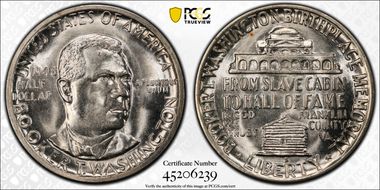

_album.jpg)
_album.jpg)
_album.jpg)



_album.jpg)




